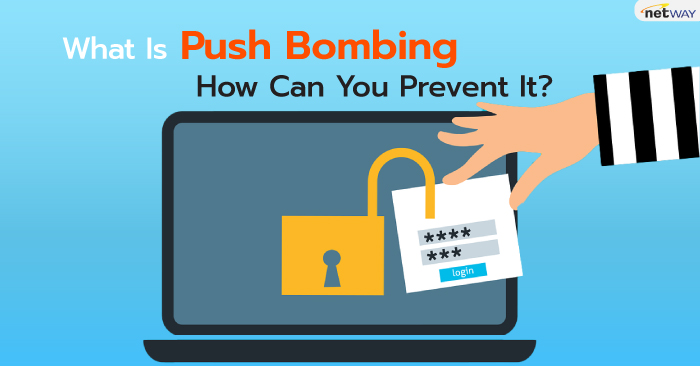-
Welcome to My Website
This is a text box. Write your own content here. This is an excellent place for you to add a paragraph.
What Is Push Bombing How Can You Prevent It

🌈Push Bombing หรือ MFA Fatique คืออะไร - ถึง MFA จะเป็นวิธีป้องกันความปลอดภัยบนโลกออนไลน์ทีดีที่สุดในวันนี้
แต่แฮกเกอร์ก็ยังมีวิธีที่จะหลอกล่อหาข้อมูลส่วนตัว หรือรหัสต่างๆ ของเราอยู่ดี
- แฮกเกอร์จะพยายาม log-in เข้าระบบหลายรอบติดๆกัน
- เหยื่อจะได้รับ push notification ถี่ๆ
- เกิดความสับสน ลืมไปว่าตัวเองกดขอ OTP ไหม
- และในที่สุดก็เผลอกดยืนยันไป
🌈เราจะป้องกัน Push Bombing หรือ MFA Fatique ได้อย่างไร
- ให้ความรู้ทุกคนในองค์กร
- เลี่ยงพฤติกรรม Application Sprawl หรือการมีแอพมาเกินความจำเป็น
- มีโซลูชั่นป้องกัน Phishing
- มีนโยบายตั้งพาสเวิร์ดที่รัดกุม
- ติดตั้งโซลูชั่นจัดการอัตลักษณ์บุคคลขั้นสูง
Cloud account takeover has become a major problem for organizations. Think about how much work your company does that requires a username and password. Employees end up having to log into many different systems or cloud apps.

Hackers use various methods to get those login credentials. The goal is to gain access to
business data as a user. As well as launch sophisticated attacks, and send insider phishing
emails.
How bad has the problem of account breaches become? Between 2019 and 2021, account
takeover (ATO) rose by 307%.
Doesn’t Multi-Factor Authentication Stop Credential Breaches?
Many organizations and individuals use multi-factor authentication (MFA). It's a way to
stop attackers that have gained access to their usernames and passwords. MFA is very
effective at protecting cloud accounts and has been for many years.
But it’s that effectiveness that has spurred workarounds by hackers. One of these nefarious ways to get around MFA is push-bombing.
How Does Push-Bombing Work?
When a user enables MFA on an account, they typically receive a code or authorization
prompt of some type. The user enters their login credentials. Then the system sends an
authorization request to the user to complete their login.
The MFA code or approval request will usually come through some type of “push” message. Users can receive it in a few ways:
• SMS/text
• A device popup
• An app notification
Receiving that notification is a normal part of the multi-factor authentication login. It’s something the user would be familiar with.
With push-bombing, hackers start with the user’s credentials. They may get them through
phishing or from a large data breach password dump.
They take advantage of that push notification process. Hackers attempt to log in many times. This sends the legitimate user several push notifications, one after the other.
Many people question the receipt of an unexpected code that they didn’t request. But when someone is bombarded with these, it can be easy to mistakenly click to approve access.
Push-bombing is a form of social engineering attack designed to:
• Confuse the user
• Wear the user down
• Trick the user into approving the MFA request to give the hacker access
Ways to Combat Push-Bombing at Your Organization
Educate Employees
Knowledge is power. When a user experiences a push-bombing attack it can be disruptive and confusing. If employees have education beforehand, they’ll be better prepared to defend themselves.
Let employees know what push-bombing is and how it works. Provide them with training on what to do if they receive MFA notifications they didn’t request.
You should also give your staff a way to report these attacks. This enables your IT security
team to alert other users. They can then also take steps to secure everyone’s login
credentials.
Reduce Business App “Sprawl”
On average, employees use 36 different cloud-based services per day. That’s a lot of logins to keep up with. The more logins someone has to use, the greater the risk of a stolen password.
Take a look at how many applications your company uses. Look for ways to reduce app “sprawl” by consolidating. Platforms like Microsoft 365 and Google Workspace offer many tools behind one login. Streamlining your cloud environment improves security and productivity.
Adopt Phishing-Resistant MFA Solutions
Enforce Strong Password Policies
For hackers to send several push-notifications, they need to have the user’s login. Enforcing strong password policies reduces the chance that a password will get breached.Put in Place an Advanced Identity Management Solution
Advanced identity management solutions can also help you prevent push-bombing attacks. They will typically combine all logins through a single sign-on solution. Users, then have just one login and MFA prompt to manage, rather than several.Do You Need Help Improving Your Identity & Access Security?
Multi-factor authentication alone isn’t enough. Companies need several layers of protection to reduce their risk of a cloud breach.บทความในส่วนนี้
-
แนวทางการใช้ Microsoft 365 Copilot เพื่อเพิ่มประสิทธิภาพการทำงาน และการสร้าง Prompt ในสายงานต่างๆ
Updated on 2025-12-03 04:57:55
-
ของขวัญปีใหม่จาก Netway ซื้อหรืออัปเกรด Microsoft 365 Business Premium วันนี้ รับคูปองเติมน้ำมันฟรี
Updated on 2025-12-01 03:55:53
-
มีอะไรใหม่ใน Microsoft 365 Copilot ช่วงท้ายปี 2025
Updated on 2025-11-27 04:07:37
-
November 2025 - Netway Combo ข่าวสารรายเดือน พ.ย. 2568
Updated on 2025-11-06 09:20:17
-
ข่าวดี! Microsoft 365 Enterprise Plan สามารถซื้อพร้อม Microsoft Teams ได้อีกครั้งแล้ว
Updated on 2025-11-05 04:07:35

-
Domain
-
Hosting
-
Cloud & Managed
-
SSL
-
Email
- เรียนรู้เพิ่มเติม
- Microsoft 365 รุ่นต่างๆ
- Microsoft 365 สำหรับธุรกิจ
- Microsoft 365 สำหรับใช้งานที่บ้าน
- ทดลองฟรี
- G Suite
- เทคนิคลดต้นทุนอีเมล Microsoft 365 มากกว่า 28%
- เทคนิคลดต้นทุนอีเมล G Suite มากกว่า 19%
- Zimbra-Based Email
- Traditional Email by cPanel
- Physical to Cloud Migration
- Exchange Server to Microsoft 365 Migration
- G Suite to Microsoft 365 Migration
- Microsoft 365 to G Suite Migration
- Cloud to Cloud Migration
-
Microsoft
-
Google
-
Marketing
-
Others
-
Blog
-
Microsoft Teams
-
microsoft-365-business-premium
-
test-slide
-
Order
-
Promo